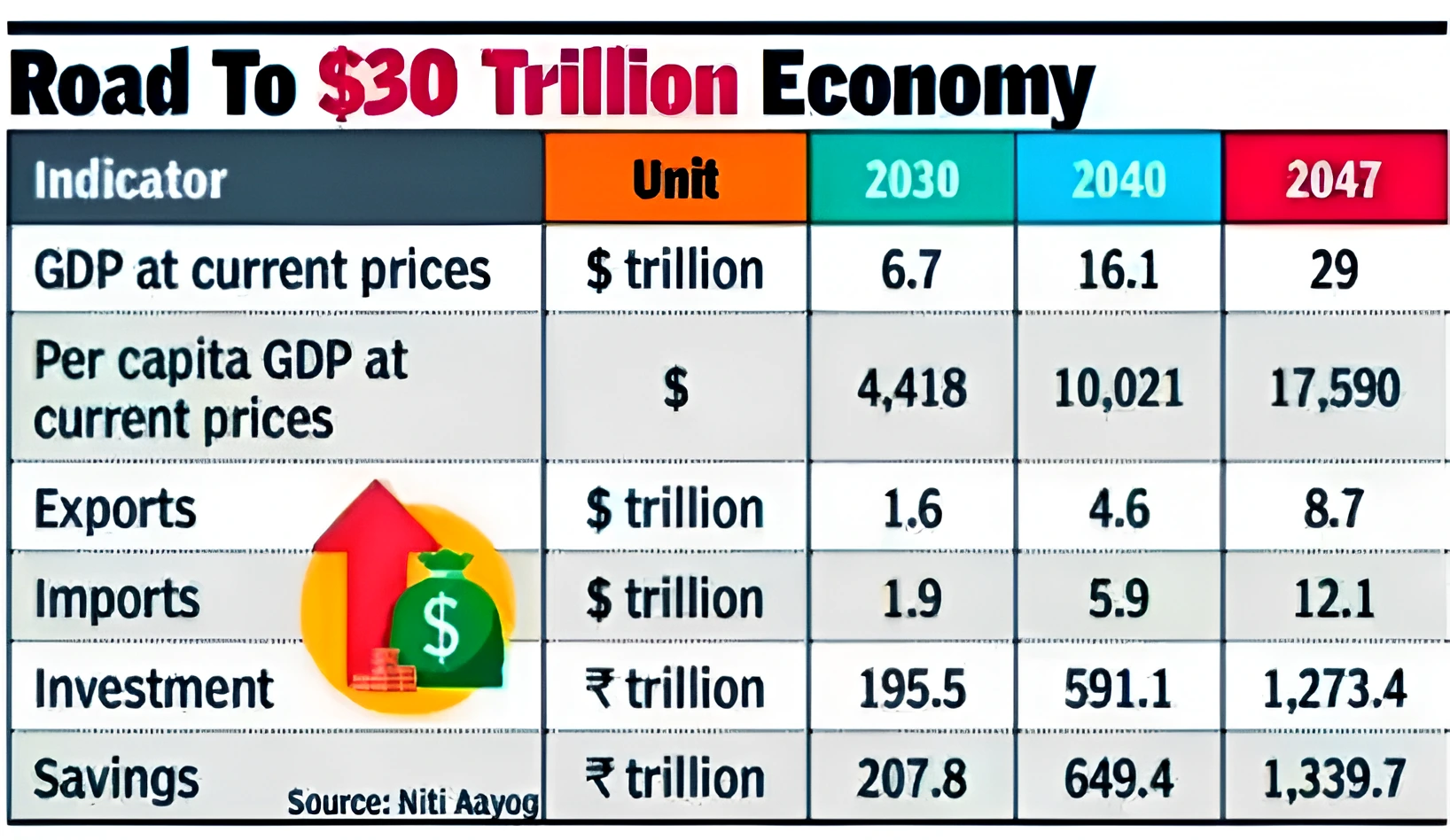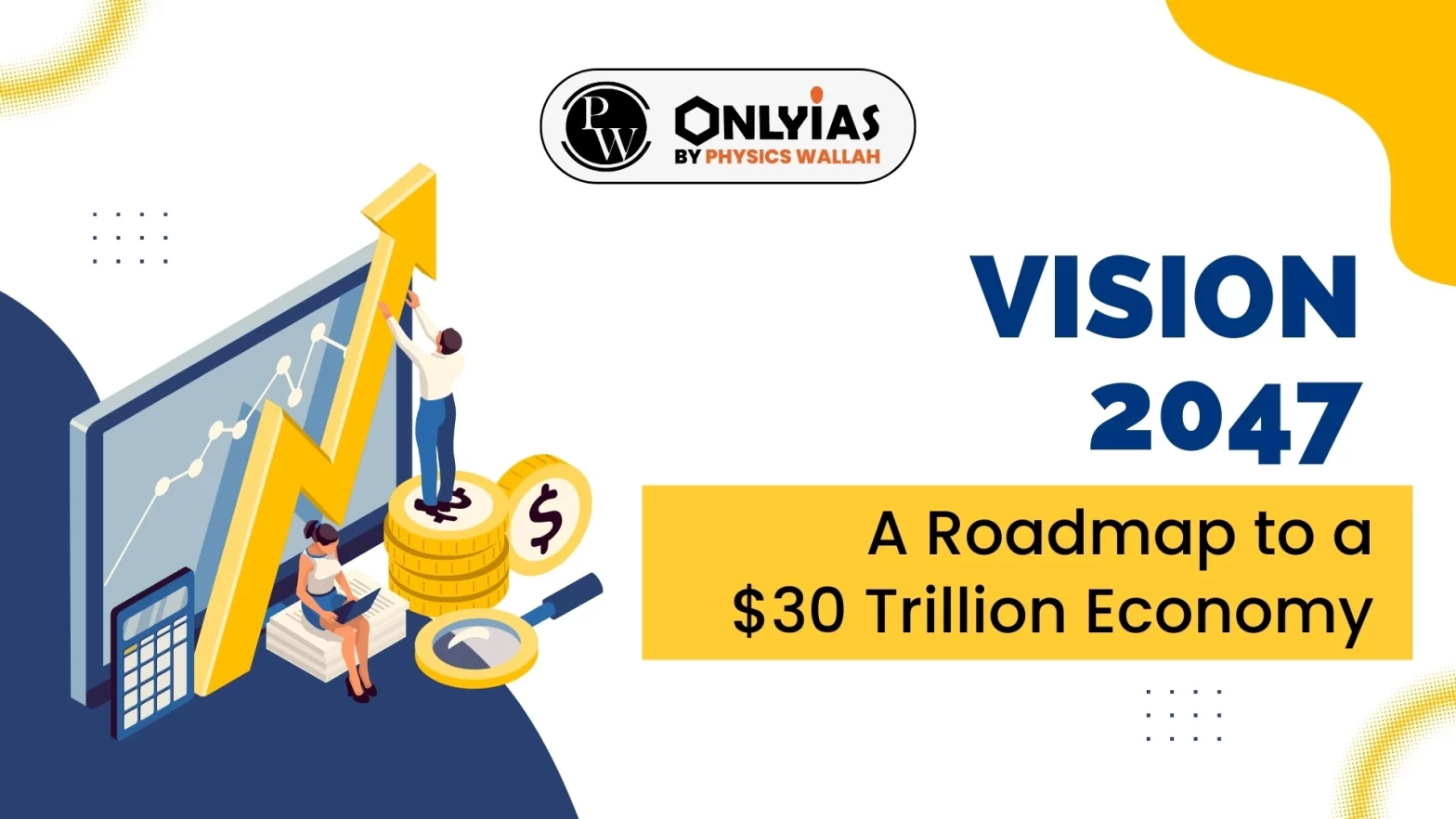Context: This article is based on an Editorial “Global equations have a symbolic role in building a developed India by 2047” which was published in the Live Mint. In early 2024, the Indian Prime Minister is expected to unveil the Vision 2047 document to transform India into a developed nation with a $30 trillion economy by 2047.
What is Vision 2047?
- Vision 2047 Document: The government’s major concern is that the country does not get trapped in the middle income trap.
- Middle-Income trap: According to the World Bank, the middle-income trap refers to a situation whereby a middle-income country is failing to transition to a high-income economy due to rising costs and declining competitiveness.
- Formulation by: NITI Aayog.
 Timeframe: The Vision 2047 document has action points and outcome goals into two periods viz. 2030, and the 17 year-period from then till 2047.
Timeframe: The Vision 2047 document has action points and outcome goals into two periods viz. 2030, and the 17 year-period from then till 2047.
Vision 2047: India’s Strengths for Attaining Developed Nation Status by 2047
- Significant Demographic Dividend: India is home to more than 600 million people aged between 18 and 35, with 65% under the age of 35.
- Vibrant Democracy: India is the largest democracy in the world with a population of around 1.44 billion people, of which around 945 million voters with a unity in diversity feature.
- Resilient Economy: India’s rapid post-COVID recovery and resilience amid the 2008 economic crisis offered proof of resilience of the Indian economy.
- Diplomacy: In this digital age, it becomes important for countries like India to employ public diplomacy as a responsible power.
- India was ranked 28th in the Global Soft Power Index 2023 report making it the second year in which the country has featured in the top 30 countries.
- Sustainable and Inclusive Development: India has been a key player in the fight against climate change.
- For instance, at the COP26 summit, India committed that it would achieve ‘net zero’ carbon emissions by 2070 and the launch of ‘Mission LiFE’- Lifestyle for Environment.
- Technology and Innovation: India is making advances in healthcare, infrastructure development using Artificial Intelligence (AI).
- For Example, The use of AI in agriculture has proved to be a game-changer with over 7000 farmers using AI to monitor the health of their crops, control quality and test their yield.
Challenges to Achieving Vision 2047
- Lack of Inclusivity: For instance, the top 10% of the population gets 57% of national income and the top 1% gets 22%.
- Globalization and technological advances have created new opportunities for some groups while leaving others behind.
- Global Uncertainty: Shocks arising from geopolitical conflicts (Eg. Israel- Hamas conflict) and adoption of protectionist policies by developed countries pose a challenge.
- Breaking Lower Middle-Income Country Status:To break Lower Middle-Income Country Status and become a high-income country, India would need to become a $60 trillion economy, 20 times the size of today.
- Other Challenges: Risks to positive GDP growth projections are predominantly hindered by challenges which include potential deterioration of banks’ asset quality, delays in fiscal consolidation, difficulties in trade agreements, and the impact of below-normal monsoon seasons, etc.-
Way forward to the achieving Vision 2047
- Harnessing Demographic Dividend: Efforts are needed to upskill millions of our working-age youth nationwide to make them industry-ready and future fit for the new sets of jobs.
- Increase Spending in Education Sector: The Government spending in the education sector in India has been under 3.5% of the GDP, compared to a global mean of about 4.5% of the GDP.
- Inclusive Growth: Women participation needs to be increased in the labor force in India besides wage parity.
- Unlocking Manufacturing Potential: India has been aspiring to grow its manufacturing sector to account for 25% of the economy from the current levels of around 15%.
-
- For Example: Schemes like the Production Linked Incentive (PLI) scheme should be implemented in a good way.
Continue Reading: Vision India@2047: Transforming India into a Developed Nation
Conclusion:
Vision 2047 is India’s plan to become a developed nation with a $30 trillion economy. To reach this goal, the country must tackle challenges like the middle-income trap and inequality, while leveraging its strengths such as a young population and technological advancements.
![]() 28 Dec 2023
28 Dec 2023

 Timeframe: The Vision 2047 document has action points and outcome goals into two periods viz. 2030, and the 17 year-period from then till 2047.
Timeframe: The Vision 2047 document has action points and outcome goals into two periods viz. 2030, and the 17 year-period from then till 2047.